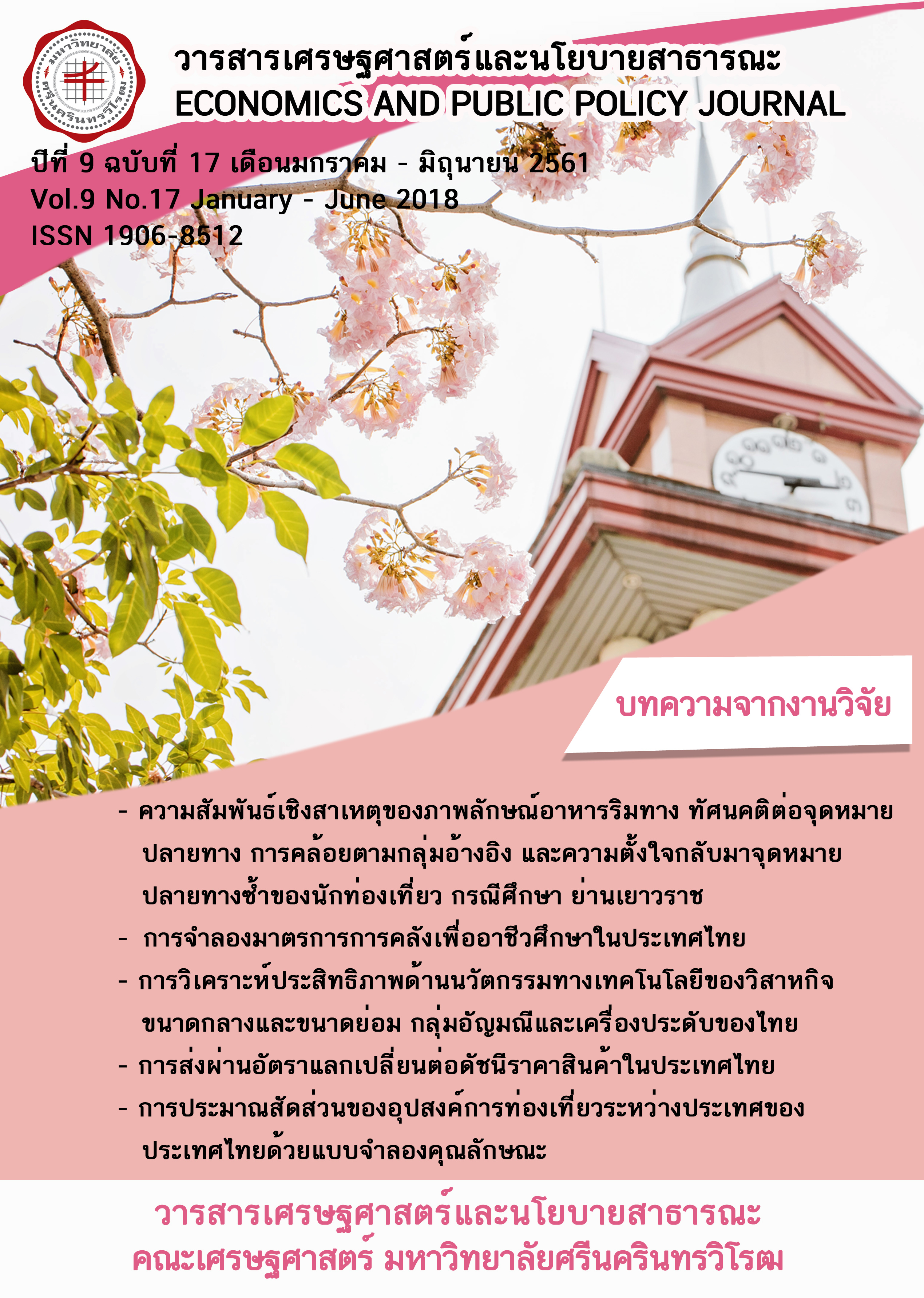การจำลองมาตรการการคลังเพื่ออาชีวศึกษาในประเทศไทย
Main Article Content
บทคัดย่อ
บทความนี้จำลองมาตรการการคลังเพื่ออาชีวศึกษาเพื่อสร้างแรงจูงใจในการตัดสินใจและนำเสนอหลักเกณฑ์ในการคัดกรองคนยากจน กลุ่มตัวอย่างเป็นหัวหน้าครัวเรือนซึ่งมีบุตรกำลังศึกษาอยู่ในชั้น ม.3 ใน 4 จังหวัดของ 16 โรงเรียน จำนวน 607 ครัวเรือน โดยใช้แบบสอบถามเป็นเครื่องมือในการรวบรวมข้อมูลและวิเคราะห์โดยใช้สถิติพรรณนาและไคสแควร์ พบว่า มาตรการการคลังเพื่ออาชีวศึกษาสามารถสร้างแรงจูงใจเปลี่ยนแปลงการตัดสินใจจากสายสามัญ (ม.4) มาเรียนสายอาชีวศึกษา (ปวช.1) คิดเป็นร้อยละ 58 ของจำนวนทั้งหมดที่ผู้ปกครองตัดสินใจให้ศึกษาต่อ ม.4 ตั้งแต่แรก และผู้ปกครองเห็นด้วยอย่างยิ่งกับมาตรการทั้งสองรูปแบบที่ให้ทุนแบบให้เปล่าเป็นค่าครองชีพแก่ผู้เรียน ปวช. เดือนละ 2,200 บาท โดยมีเกณฑ์คัดกรองผู้รับทุนต้องมีรายได้ไม่เกิน 100,000 บาทต่อปีหรือไม่เกิน 8,300 บาทต่อเดือน ครัวเรือนไม่มีสภาพคล่องทางการเงิน และเงื่อนไขอื่น ๆ ซึ่งใช้การให้คะแนนจัดลำดับตามความจำเป็น และมีวิธีการคัดเลือกโดยแต่งตั้งคณะกรรมการคัดกรองนักเรียนยากจนจากหน่วยงานต่าง ๆ ของรัฐทั้งในระดับชาติ และระดับพื้นที่ โดยใช้งบประมาณแผ่นดินของรัฐ อปท. และ กยศ. จัดสรรทุนตามโควตาพื้นที่ (ภูมิภาคและจังหวัด) และตามสัดส่วนความหนาแน่นของคนจนในแต่ละจังหวัด ดังนั้นจึงควรนำมาตรการการคลังเพื่ออาชีวศึกษาดังกล่าวมาทดลองใช้ในประเทศไทยเพื่อใช้เป็นนโยบายเพิ่มสัดส่วนผู้เรียนอาชีวศึกษา และเพิ่มโอกาสทางการศึกษาแก่ครัวเรือนยากจนตามนโยบายของรัฐ
Article Details
สงวนลิขสิทธิ์ © 2553 คณะเศรษฐศาสตร์ มหาวิทยาลัยศรีนครินทรวิโรฒ
คณะเศรษฐศาสตร์ มหาวิทยาลัยศรีนครินทรวิโรฒ จัดพิมพ์วารสารเศรษฐศาสตร์และนโยบายสาธารณะ เพื่อเผยแพร่บทความวิชาการทางเศรษฐศาสตร์ นโยบายสารธารณะ และสาขาอื่นๆที่เกี่ยวข้อง ทัศนะและข้อคิดเห็นใดๆ ที่ปรากฏในวารสารเป็นความคิดเห็นส่วนตัวของผู้เขียน โดยบทความที่ได้รับการตอบรับจะถือเป็นลิขสิทธิ์ของคณะเศรษฐศาสตร์ มหาวิทยาลัยศรีนครินทรวิโรฒ
บรรณาธิการ อาจารย์ ดร.พลพัธน์ โคตรจรัส
เอกสารอ้างอิง
ธิติมา พลับพลึง. (2557). ความเหลื่อมล้ำของโอกาสการศึกษา ทรัพย์สินครัวเรือน และกรณีศึกษาทางเลือกการศึกษาสำหรับครัวเรือนยากจน. ปริญญานิพนธ์ปรัชญาดุษฎีบัณฑิต สาขาเศรษฐศาสตร์ สำนักวิชาเศรษฐศาสตร์และนโยบายสาธารณะ มหาวิทยาลัยศรีนครินทรวิโรฒ
สมเกียรติ ตั้งกิจวานิชย์ และ อารียา มนัสบุญเพิ่มพูน. (2550). การประเมินกองทุนเงินกู้ยืมเพื่อการศึกษา. สถาบันวิจัยเพื่อการพัฒนาประเทศไทย.
สมชัย ฤชุพันธุ์ และ ชลธาร วิศรุตวงศ์. (2544). รายงานวิจัยแนวทางการบริหารจัดการกองทุนเงินให้กู้ยืมเพื่อการศึกษา. กรุงเทพฯ : สกศ.
สำนักงานเลขาธิการสภาการศึกษา กระทรวงศึกษาธิการ. (2554). นโยบายและยุทธศาสตร์การปฏิรูปการศึกษาในทศวรรษที่สองด้านการพัฒนาอาชีวศึกษา. กรุงเทพฯ.
Behrman, J. R. & J. C. Knowles. (1999). Household Income and Child Schooling in Vietnam.The World Bank Economic Review, 13 (2), 211–256.
Cochran, W. G. (1953). Sampling Techniques. New York: John Wiley & Sons.Chapman B. et al. (2010). Thailand’s student loans fund : Interest rate subsidies and repayment burdens. Economics of Education Review, 29(2010), 685-694.
Cunha. F., and Heckman, J. (2007). The technology of skill formation. American Economic Review, 97(2), 31-47.
Cunha, F.,J.J Heckman, L.J. Lochner, and D.V. Masterov (2006). Interpreting the evidence on life cycle skill formation. In E. A. Hanushek and F. Welch (Eds.), Handbook of the Economics of Education, Chapter 12, pp. 697-812.
Amsterdam: North-Holland.Gurley-Alloway, T. (2009). More Than Money : Higher Education Decisions of Low-Income And Minority Students. Dissertation Doctor of Philosophy, The University of Texas At Arlington.
Fiszbein, A. and Schady, N. (2009). Conditional Cash Transfers Reducing present and Future Poverty.
Gurley-Alloway, T. (2009). More Than Money : Higher Education Decisions of Low-Income And Minority Students. Dissertation Doctor of Philosophy, The University of Texas At Arlington.
Heckman, J.J. (2000). Policies to foster human capital. Research in Economics 54(1), 3-56. With discussion.
Heckman, J.J. (2008). Schools, skills and synapses. Economic Inquiry. Forthcoming.
Heckman, J.J. and D.V. Masterov (2007). The productivity argument for investing in young children. Review of Agricultural Economics 29(3), 446-493.
Janvry, A. F. Finan, E. Sadoulet, D. Nelson, K. Lindert, B. de la Brière and P. Lanjouw (2005) “Brazil’s Bolsa Escola Program: The Role of Local Governance in Decentralized Implementation”, Social Protection Discussion Paper #0542, The World Bank, December.
Morley, Samuel and D. Coady, (2003). From Social Assistance to Social Development: targeted education subsidies in developing countries, (Center for Global Development and IFPRI, 2003).
Patrinos, Harry Anthony (2002). A Review of Demand-Side FinancingInitiatives in Education. World Bank Report No.26959, Working Paper (PDF) https://tinyurl.com/y9rexl3
Patrinos, Harry Anthony & Ariasingam, David Lakshmanan (1997). Decentralization of Education: Demand-Side Financing. Washington DC: The World Bank.
Pimpa, N. (2007). Reference groups and choices of vocational education : Case of Thailand. School of Education, RMIT University.
Pimpa, N. & Suwannapiron, S. (2008). Thai students ’ choices of vocational education : marketing factors and reference groups. Educational Research for Policy and Practice. Vol. 7, Issue 2, pp.99-107.Schultz, T.P. (2004). School subsidies for the poor: evaluating the Mexican Progresa
Poverty Program. Journal of Development Economics 74 (1), 199-250.
Stampini, M. and Tornarolli, L. (2012). The Growth of Conditional Cash Transfers in Latin America and the Caribbean: Did They Go Too Far? IDB Policy Brief n. 185. Washington D.C., USA: Inter-American Development Bank.
UNDP. (2014). Thailand Human Development Report 2007 Sufficiency Economy and Human Development. Bangkok, Thailand.


